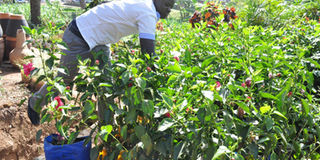How to care for flowers

Whether one grows flowers for domestic consumption or for the export markets, they require a lot of care and special attention. PHOTO BY RACHEL MABALA
What you need to know:
To have a productive flower farm, you have to pay more attention at the transplanting, reproductive and harvesting stages.
To have a productive flower farm, you have to pay more attention at the transplanting, reproductive and harvesting stages.
Although some flowers are planted directly to the main garden, most are are first grown in a nursery bed and later transplanted.
Henry Sendagire, a horticulturalist, at College of Agricultural and Environmental Sciences, Makerere University, says special care needs to be taken at the various stages.
“At transplanting, apply fertilisers preferably NPK [Nitrogen, Phosphorous and Potassium] between 20 to 28 grammes per plant. Put it in the hole before putting the seedling,” advises Sendagire.
Applying fertilisers
NPK contains three main nutrients needed by plants for different reasons; Nitrogen promotes leaf growth, phosphorous is for the roots and potassium is for flowering.
Measuring the fertiliser in grammes may be difficult, you can use a teaspoon. It is about 10 grammes so apply two to three teaspoons per plant.
If the soil is poor, Sendagire says, repeat the process every month until the flowering stage. Otherwise, then you reapply the fertiliser when the flowers bloom.
This is a critical stage of growth flowers use a lot of energy to reproduce and therefore should be fed a lot. Therefore, fertilisers should be applied every month once the flowers appear and watering intensified.”
Use either ammonia sulphate or urea; in case of the former apply 28 grammes per plant and the latter14grams per plant. Draw circles around the fibrous roots and apply the fertiliser there.
Sendagire says that most farmers use local manure. This is a combination of chicken droppings with goat droppings or cow dung.
This should be applied at transplanting. When you use inorganic manure, it lasts longer in the soil so you do not have to keep reapplying it.
Harvesting
Harvesting is the most difficult stage because you have to deliver a fresh flower to a client no matter the distance. Also customers have different preferences, as some want when the flower is fully out while others prefer when flower is in full bloom.
Sendagire however advises that you harvest when the bud is at the initial stage of opening and make a clean cut at a slanting angle. “Avoid many bruises on the stem with clean cuts. Cut at an angle and after put it in a bucket with a solution or water.”
He explains that the pointed end of a cut stem minimises bacteria from spreading all over the plant. Only a small part touches the bottom of the container in which it is stored as opposed to the one cut flat that would entirely touch the bottom.
Not all weather is suitable for harvesting; so it is recommended that this is done when it is stored in a shade.
Post-harvest handling
In case the flowers are destined for distant markets, prepare a simple sugar solution; put one teaspoon of sugar in a litre of water. Add three drops of vinegar or lemon and then keep the flowers there.
“This will keep the flowers fresh because all living creatures get energy through sugar,” he says.
Also do not be rough on the flowers, use big boxes to absorb shock. Keep the flowers there while moving them to avoid bruising .
“Flowers are luxurious so do everything in terms of packaging to appease the buyer,” Sendagire notes.
Handling flowers for export
When growing flowers for export, you should get phytosanitary permission and also protect the flowers from all pests and diseases by regularly spraying. But use the recommended chemicals on the market.
Also, do not spray today and harvest tomorrow. Give the flowers more than two days for the chemical to wear off.
Although spraying is not limited to flowers for export, he emphasises that the flowers for export should be sprayed even before you see a sign of a pesticide. The spraying should start once the flowers get firm in the soil.
Spacing
The minimum spacing between flowers should be 45 x30 cm or 60 x 30 cm between rows and columns.




